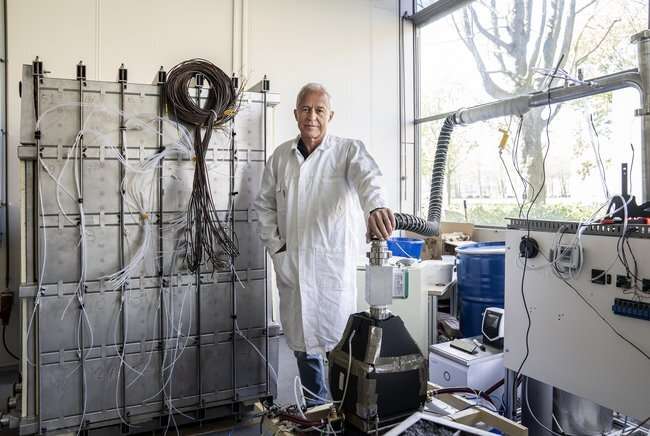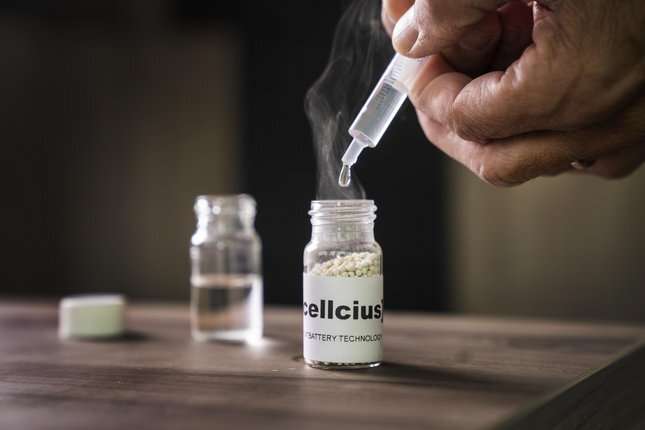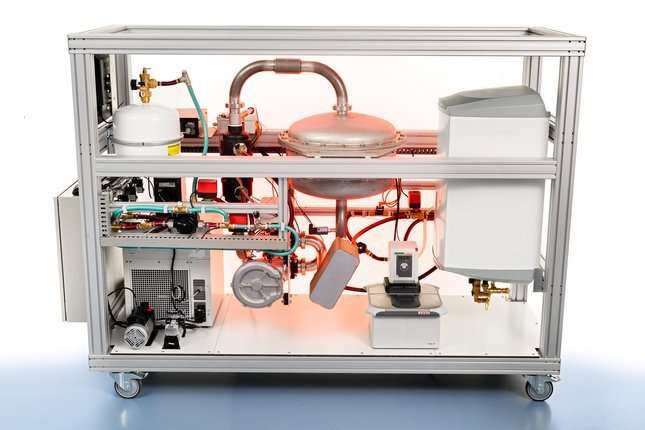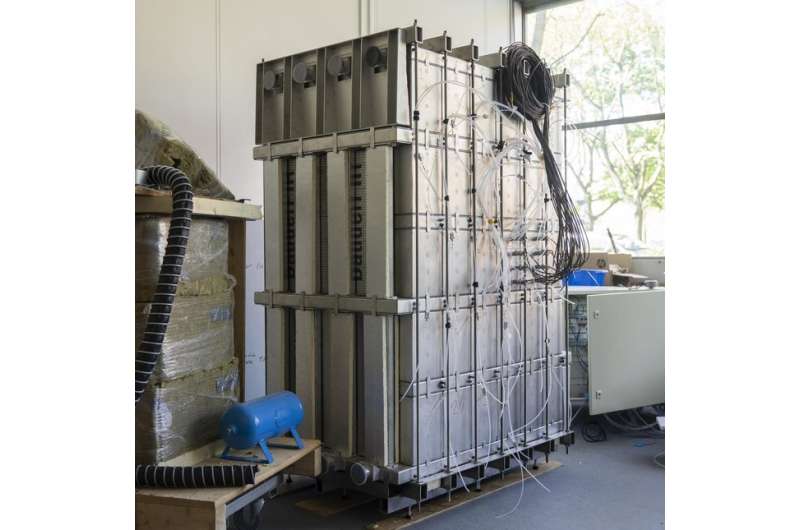How a new heat battery can quickly make millions of homes gas-free

The need to take homes off gas has increased ever since the conflict in Ukraine. A heat battery with salt and water as simple components could provide a quick and large-scale solution for over three million households in the Netherlands—twice the target set by the Dutch government. This heat battery, being developed by a consortium of Eindhoven University of Technology, TNO, spin-off Cellcius and industrial partners, is cheap, compact, loss-free and now ready for the first real-world tests.
With heat storage in homes and by harnessing the vast amounts of industrial waste heat that would otherwise be thrown away, this battery is a potential game-changer for the energy transition. Here are four reasons to get charged up for the arrival of this innovative battery.
1. The basis of the battery is amazingly simple
A simple experiment immediately reveals the essence of the heat battery. Fill a small bottle with white salt grains, add a little water and it starts to sizzle. Moreover, as if by magic, the bottle instantly feels incredibly hot. Olaf Adan has demonstrated the experiment countless times, amazing onlookers time and again.
Adan, TU/e professor and principal investigator at TNO, is at the heart of the Eindhoven heat battery, which essentially revolves around a relatively old thermochemical principle: the reaction of a salt hydrate with water vapor. "The salt crystals absorb the water, become larger and, in the process, release heat," says Adan. Hence the rapidly warming bottle.
But the reverse is also possible. "By adding heat, you evaporate the water off and basically 'dry' the salt, thus reducing the size of the salt crystals," Adan explains. As long as no water gets to this dry salt powder, the heat is always stored in it. So, unlike with other types of heat storage, nothing is lost: The battery is completely loss-free.
You can repeat this process endlessly, one way or the other, thereby providing the basis for a heat battery that can store heat and use it at a later time and in a different place. This is a solution for the fluctuating supply of renewable energy in homes and buildings, and for the expedient reuse of 'heat waste' in another place.
While the principle of the battery may be simple, applying it in a battery certainly is not. Witness the fact that Adan has been working on this for over 12 years. For example, the choice of the specific salt material is not self-evident. There are thousands of known reactions of salt hydrates with water. Adan studied them all in great detail, ultimately discovering that only a very limited number have the right properties for use in a battery.
"A salt crystal like that gets bigger and smaller, heat goes in and out all the time. So something happens to such a particle. As a result, it can quickly disintegrate or clump together with other particles. So you need a material that you can continue to use cyclically," says Adan. In the end, he and his team settled on potassium carbonate as a basis, an easily extracted salt that can be found in many products, such as food, soap or glass.
Then you also need a device that will make full use of the potential of this material. If it has to fit in a house, it has to be compact, and preferably also affordable as well as highly efficient. "So you start looking at all kinds of reactor concepts, such as in a vacuum or with open air, but without success to date," says Adan.

Eventually, Adan arrived at the so-called closed-loop system, a demonstrator of which he built in 2019. This recirculating system consists of components including a heat exchanger, fan, evaporator/condenser and a boiler with salt particles. At 7 kWh, the thing was still pretty minimal—in theory, this could provide heating for a typical family of four for two days.
"It still looked pretty basic, with existing, mature technology, but it allowed us to demonstrate that our concept, simple as it was, worked." Evidence that allowed Adan within the European consortium HEAT-INSYDE (including TU/e, TNO, Caldic and parties from France, Belgium, Poland and Switzerland) to win a European subsidy of seven million euros for further development. The team then set to work to 'upgrade' the demonstrator to a prototype ready for use in practice. This has now been achieved.
2. The technology is optimized for real-world use
In terms of dimensions, the prototype that has now been realized is probably comparable to the demonstrator, but that is where the visible similarities end. The prototype looks like a sort of large cabinet with dozens of lockers, with all sorts of loose cables sticking out of the side.
Amazingly, each duo of small "lockers" represents a heat battery that matches the entire, original demonstrator in terms of storage capacity. The whole device contains some 30 "lockers," with a total storage capacity of over 200 kWh. Adan puts it into perspective: "That's equivalent to two fully charged Tesla's."
"We have optimized the earlier version in countless ways," Adan proudly explains. "We redesigned the individual components, such as the evaporator and heat exchanger, made better use of space and used other materials." Meanwhile, the unit also includes a measurement and control system, for example, so that you know when to charge and how much heat is left in the system.
Most applications do not require such a large battery. That's why we deliberately chose those multiple, small units that you can combine at will; a modular system, in other words. "If you have one big container of salt, you have to start using it all at once. That's really inefficient," says Adan. So you can use 'bits' of the battery, separate from the rest.
In addition, the separate units offer all kinds of design possibilities, making different shapes and sizes possible, depending on the desired practical situation. Adan speaks of a user-oriented prototype. "It is not yet a product, but everything is now ready to be tested for the first time in a real-world situation."
And that testing will start later this year, with the first pilots of the heat battery in homes. A battery of about 70 kWh will be installed—enough to last a few days without sun or wind—in four homes, two in Eindhoven, one in Poland and one in France.
Even though it is "only" four homes, Adan expects that they will "learn an awful lot from this." For example, testing is going to provide valuable input as to what else is needed in practice to apply the battery on a large scale as well as what the user thinks of it. For example, should there be an app to operate the battery?

3. Heat transport is crucial in the energy transition
The idea that started it all was the heat battery as a storage medium in homes. In the meantime, however, the consortium is also looking at heat storage in office buildings, greenhouse horticulture or, for example, electric buses or luxury ships.
But, they realized, if this thermal battery can store heat loss-free, it can also be transported loss-free. After all, nothing else happens to the dry salt as long as no water is added. This is exactly where the thermal battery could make the difference, because other forms of heat transport, such as through pipes or phase transitions, always run up losses.
The consortium therefore also focuses their attention on industrial residual heat as a heat source, a kind of "heat waste," such as that generated as a by-product in factories or surplus heat from data centers. This heat is not so "hot" anymore; at temperatures below 150 degrees Celsius it has no value for most industry.
For homes, however, such heat is very useful. Such temperatures are more than sufficient for heating your home or taking a hot shower. If industrial residual heat could be used to heat homes, you have a win-win situation: homes could be made independent of gas—an even more urgent need given the dependence on (Russian) gas—and CO2 emissions would be reduced.
Adan does a quick calculation. "In the Netherlands we have about 150 PetaJoule (a number with 15 zeros) of residual heat from industry per year. That would enable you to take almost 3.5 million homes off the gas, which is more than twice the target of the Dutch government, namely 1.5 million homes gas-free by 2030."
If you superimpose the locations of the sources of industrial residual heat and homes on a map of the Netherlands, Adan says the match is reasonably good. There is no more than 30 kilometers between them.
However, that's still too much for heat grids, the method the government is now focusing on. "Heat grids use pipes with water, which cools and therefore limits your radius of action," Adan explains. "In addition, heat grids have a hefty investment risk and the entire landscape has to be broken open to build them—not an attractive option."
With a consortium including Cellcius (more on that in a moment), Ennatuurlijk, Demcon, SiTech, TNO, Brightside and SABIC, Adan is therefore now preparing a real-world test trial to use the heat battery for the reuse of industrial residual heat. Residual heat from the Chemelot Campus in Sittard-Geleen will be transported to about fifty homes in the neighborhood in the same municipality.
Adan: "With a heat recharging station at SABIC we collect heat and dry the salt. We then drive this salt by truck to a sort of 'transformer house' in the residential area, from where the fifty homes are supplied with heat via pipes. So we don't have to be in the homes themselves."

And yes, using trucks is not climate-friendly, but Adan can reassure everyone. "The emissions from this are negligible compared to the emissions we save with this heat transport. Furthermore, we want to switch over to electric trucks soon."
The pilot is due to start in the course of next year, when the first trucks loaded with "energy" can hit the road.
4. The move to valorization strengthens the development
Now that the technology is about to be rolled out in society, steps have also been taken on the organizational and financial side. For example, spin-off Cellcius—the first combined TNO and TU/e spin-off—was founded at the end of 2020. "The company was formally founded on the 11th of the 11th, as it should be in Brabant," laughs Adan, in a nod to the date of the traditional start to Carnaval.
The young company is still small, with five people at the moment. But Adan expects them to have grown to about 10 to 15 people by the end of the year. "Also, from Eindhoven Engine, we are getting a lot of students from all kinds of studies to collaborate on various aspects."
Since the seven-figure European grant, a lot of additional funding has also been secured to enable the realization of the upcoming residential pilot project. And thanks to recent investments from the Brabant Development Corporation, Innovation Industries and the GoeieGrutten Impact Fund, the final touches have been put to the financial picture for the heat transport pilot.
Now that Adan, through Cellcius, is no longer involved purely as a researcher but also has one foot in valorization, he sees how this interaction has an amplifying effect on the technology. "Because you're now really working on a product, that in turn generates new questions for the groundwork, the technology. This is a wonderful example of co-creation and how it allows you to accelerate that cycle."
Despite the great promise of the technology he has at his disposal, Adan remains down-to-earth. "While the potential is great, we have also seen many great potential technologies that have not made it. So we're going to keep our feet on the ground and take this one step at a time. I'm only in this for one thing: it's great to be able to contribute to the energy transition."
















